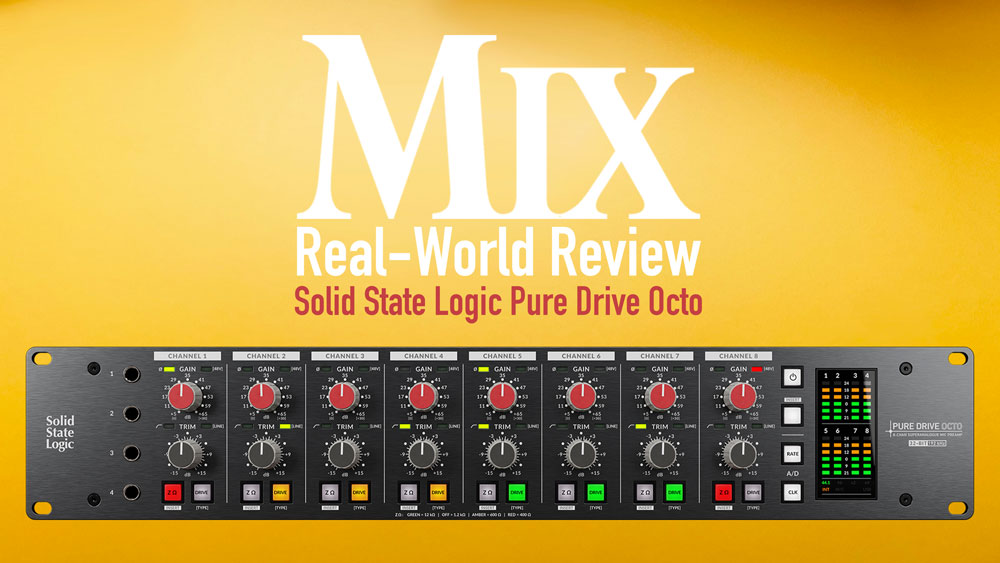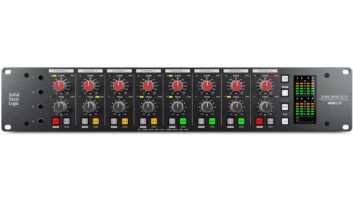
| MIX VERDICT: SSL PURE DRIVE OCTO |
| THE TAKEAWAY: “Using the SSL Pure Drive Octo was an absolute pleasure.” |
| COMPANY: Solid State Logic • www.solidstatelogic.com PRICE: $2999.99 MSRP; available at dealers for $2499.99. PROS: • Intuitive operation. • Excellent sound. • Low noise floor. • Versatile connectivity. CONS: • No monitor output. • Metering is not adjacent to channel controls. |
Solid State Logic manufactures a wide range of tools for music production, and late last year introduced its latest stand-alone microphone preamplifiers: the Pure Drive Octo (8-channel) and Pure Drive Quad (4-channel) mic preamps.
Both units feature SSL’s SuperAnalogue PureDrive microphone preamp technology originally developed for the Origin console, onboard A/D conversion at sample rates up to 192 kHz, extensive connectivity, and a USB interface for direct connection to a DAW. The subject of this review is the Pure Drive Octo.
The Pure Drive Octo occupies two rackspaces and has a depth of about 12 inches. The front panel is cleanly arranged, with (left to right) four ¼-inch instrument inputs, controls for each of the eight input channels, four setup buttons and a metering/status display.
The rear panel provides eight XLR mic/line combo jack inputs, four XLR AES/EBU outputs, dual ADAT outputs, a USB Type-C port, BNC jacks for word clock I/O (plus a termination switch), and DB25 jacks for line input, analog out/send, and return. A hard power switch and IEC receptacle round out the rear-panel features. Once the rear-panel switch is turned on, the unit can be powered on or set to standby using the front-panel power switch.
The circuit topology behind the Pure Drive Octo is what SSL describes as a “progressive analogue design,” with no potentiometers or relays in the audio path. Analog circuits are digitally controlled via front-panel controls, an approach that enables precise repeatability and matching between channels (within a dB). Onboard A/D conversion is (up to) 24-bit/192 kHz for AES or ADAT, or 32-bit/192 kHz via USB. Dual ADAT ports support 16 outputs at 44.1 or 48 kHz, or SMUX (dual-port) output at higher sample rates with reduced channel count (up to 176.4/192 kHz).
Each channel provides two knobs and two pushbutton switches. The Gain knob varies from 5 to 65 dB in 6 dB steps, while the Trim control adds or subtracts 15 dB to those values in 1 dB steps. Pushing the Gain knob reverses the polarity; pushing and holding it briefly turns phantom power on or off (phantom-power switching was virtually silent). Pushing the Trim knob toggles the high-pass filter on or off (75 Hz, 18 dB/octave, fixed); holding it changes the input to Line. When an instrument cable is connected to any of the ¼-inch instrument inputs, the respective channel input is automatically set to the DI.

CLEAN, CLASSIC, ASYMMETRIC
Two illuminated buttons beneath the Gain and Trim knobs provide access to a wide range of tonal options. The ZΩ button toggles through four microphone input impedance settings: 12kΩ (green), 1.2kΩ (white), 600Ω (amber), or 400Ω (red). The Drive button sets the channel Drive mode to Clean (white), Classic Drive (amber), or Asymmetric Drive (green), and flashes red when the preamp clips (as does the channel meter). Deciphering the color codes for these buttons was one of the few times I needed a trip to the manual, but in practice, I set them by ear.
The PureDrive circuitry used in the Pure Drive Octo offers the same two drive modes used in the Origin console (Clean and Classic Drive), plus a third option called Asymmetric Drive. Clean mode yields a linear, low-noise character designed for transparency and detail. Classic Drive is a symmetrical mode that generates predominantly odd harmonics. Asymmetric Drive emphasizes even harmonics and softens transients. I enjoyed using the Clean mode most often, but Classic Drive and Asymmetric Drive came in handy for adding some hair to an electric bass or a synth pad.
The differences between these modes aren’t apparent until you start to push the preamp into clipping, and I found them to be subtle on most sources. Used with a Shure SM57 on snare drum, for example, Classic Drive rounded the transient of the stick hitting the head; pushing the preamp harder in Asymmetrical mode added a bit of aggressiveness to the tone.
One particular application where I really liked the Asymmetrical Drive was in combination with a pair of Coles 4038 mics for drum overheads, or with a Sennheiser e602 on kick, where I could push the preamps into clipping to add some trash to the sound.
I used the Pure Drive Octo as a traditional standalone analog in/analog out mic preamp, as a preamp and A/D converter routed into my main interface (a Metric Halo Labs LIO8) via ADAT, and as a USB interface.
My preference was using it with the LIO8 via the ADAT ports, which enabled me to expand the input capabilities of the LIO8 from 8 to 16 channels without need for unnecessary A/D conversion. I patched word clock out from the LIO8 to word clock in of the Pure Drive Octo, ran a Lightpipe cable from the Pure Drive Octo ADAT out into the LIO8, and set the clock source of the Pure Drive Octo to word clock in. Piece of cake. The Pure Drive Octo followed changes made to the sample rate in my DAWs, and locked like a champ. Higher sample rates decrease the channel count when using the ADAT and AES outputs, but do not decrease the channel count when using the Pure Drive Octo as a USB interface.
Audibility of changing the microphone input impedance depends upon the microphone, with condenser mics showing little change and ribbon or low-output moving-coil mics showing more significant changes. Generally, as the impedance dropped, so did the output level of the microphone, but there were also subtle changes in timbre. When using the Pure Drive Octo with my RCA 44BX, for example, the bottom end tightened up as impedance was lowered, but the 400Ω setting also opened up the top a bit and was absolutely gorgeous for recording acoustic guitar.
My advice: Push the button and use your ears.

AS AN INTERFACE
Using the Pure Drive Octo as a DAW interface requires a bit of explanation. First, the easy part: Connect the Pure Drive Octo to your computer with a USB cable and it shows up as an audio interface with 8 inputs. The factory configuration, however, does not provide any audio outputs from the DAW. The AES and ADAT outs normally carry the preamp outputs post-A/D, but can be “repurposed” as DAW outputs—which you’ll need to do when using the Pure Drive Octo as the sole interface.
You’ll also need some sort of D/A conversion to hear those outputs, which is a bit of a drag and why I’d love to have some sort of basic monitor output such as a headphone out. You can, of course, use the Pure Drive Octo with another interface to create an Aggregate Device, but don’t blame me if your DAW software gets cranky when using Aggregate Device as the interface, which has been my experience. No driver is required when using the Pure Drive Octo with Mac OS; using it under Windows requires the SSL USB ASIO/WDM Audio Driver.
Universal Audio Verve Analog Machines Plug-In — A Mix Real-World Review
Regardless, to repurpose the AES or ADAT outs as DAW outputs, the Pure Drive Octo must be booted into Configure mode by holding the CLK button while powering on (the manual does not specify that this needs to be done using the rear-panel switch). Once the Pure Drive Octo is in Configure mode, you can also access system settings such as meter or button brightness, auto standby timeout, peak hold time, and more. These settings will be saved when exiting Configure mode, done by holding the Standby button until the unit restarts.
There’s one more feature of the Pure Drive Octo that merits discussion, and that’s the rearpanel analog output/insert send and insert return connectors. Each channel has a switched insert activated by holding the Insert button and tapping ZΩ on the respective channel. The insert return is pre-A/D, allowing you to add a processor to the recording path on the way to the DAW. This is a very useful feature for situations where you’d like to route to the DAW using AES or ADAT output but want to add, for example, an analog compressor to the signal path. There’s no insert status indicator on each channel. Insert status is viewed by holding the Insert button in the “master” section, which causes the ZΩ button to flash green for any channel with an active insert.
Using the SSL Pure Drive Octo was an absolute pleasure. It does what it’s supposed to do, the interface is easy to navigate, and the preamps are quiet while delivering excellent sound. Front-panel metering is modest but provides the information you need. It offers analog and digital connectivity options that make it extremely useful for a variety of applications, and the impedance and drive features provide a range of tonal colors, should you so desire. No question here: SSL has a winner on its hands.







